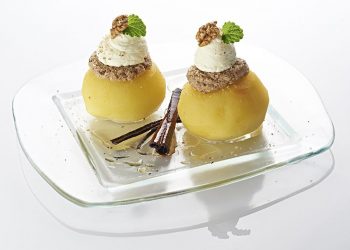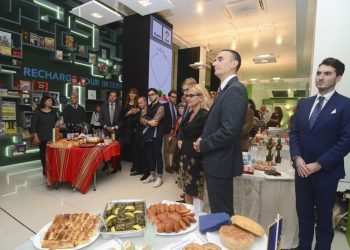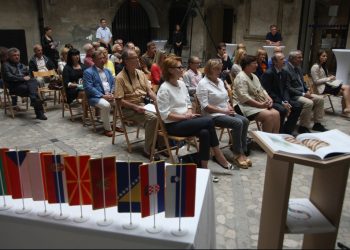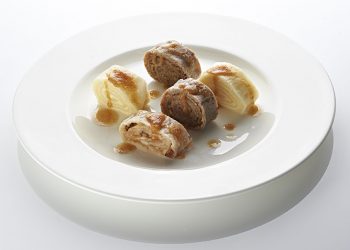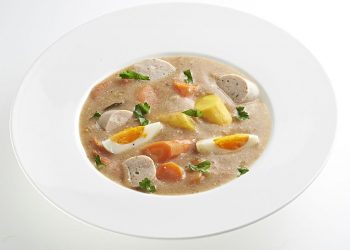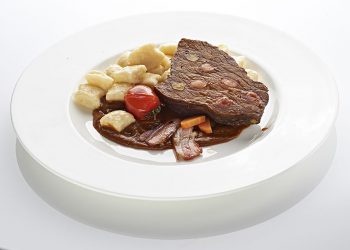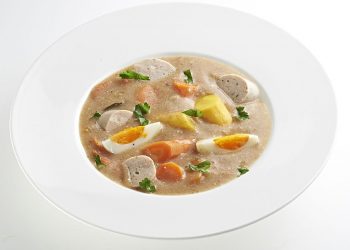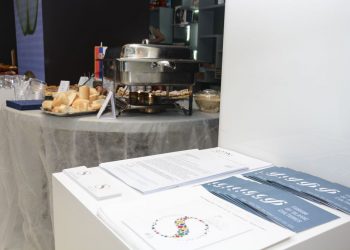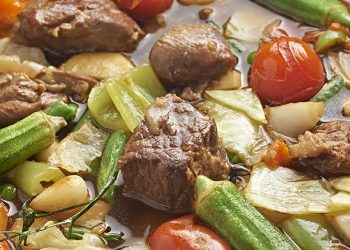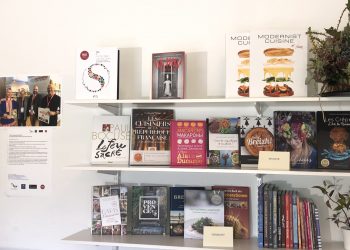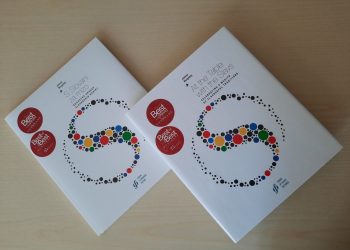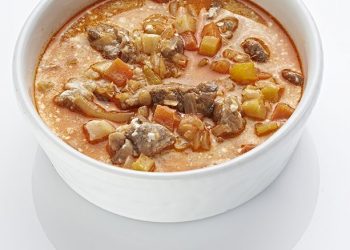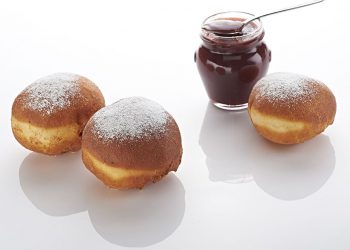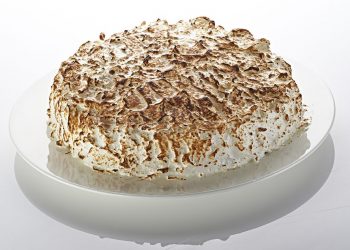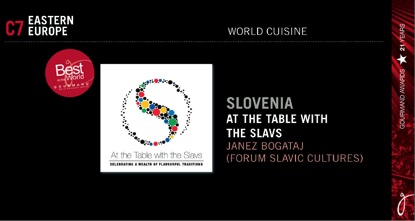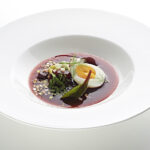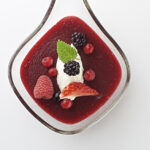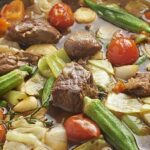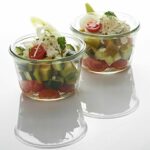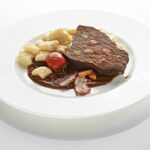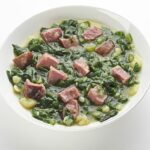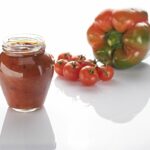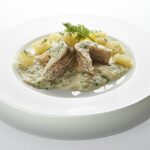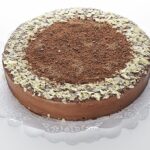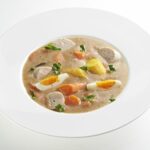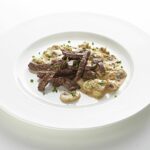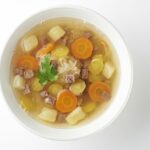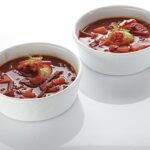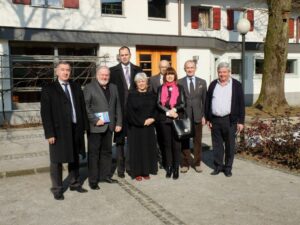За столом са словенима
- Прва светска монографија,,
- Истоимена изложба
- Разна догађања као што су: дегустација јела из књиге, дипломатски пријеми, представљање књиге на сајмовима књига…
“У већини земаља расте свест да је храна део националног идентитета и међународног имиџа. Тиме се у први план ставља и ново поштовање према храни и локалним производима, као и повратак на локална јела у новим трансформацијама. Кувари чувају рецепте из прошлости од пребрзог заборава. Кључна улога тих кувара је преношење и очување нематеријалне културне баштине човечанства с генерације на генерацију, како то признаје Унеско.”
Едуар Коантро, председник и оснивач Gourmand World Cookbook Awards
О КЊИЗИ
- Аутор текстова: др Јанез Богатај
- Фотографије: Томо Јесеничник
- Припрема и обликовање хране: Hiša kulinarike Jezeršek
- Art direction и дизајн: Еди Берк
- Објављено: 2015. на енглеском, 2017. на словенском
БОГАТСТВО УКУСА
The cuisine of Belarus has a lot in common with Polish and Lithuanian cooking traditions, but has been influenced also by other Baltic, Slavic as well as Jewish and Germanic cuisines. Another strong influence were the Lithuanian (Lipka) Tatars, whose cooking relied heavily on flat breads and pies with different fillings, mutton and vegetable dishes.
A blend of so many different traditions, Belarusian cuisine is one of the most diverse in the region, but offers, despite similarities with other cooking traditions, a variety of original dishes. Historically, different trends could be observed in Belarusian cuisine, with each social class developing its own gastronomic tradition.
(Text: Janez Bogataj, PhD)
Dishes
- Haladnik / Cold Soup Haladnik
- Draniki / Potato Pancakes
- Kisel / Kissel
The ethnic diversity that characterises the country is reflected also in its culinary tradition.
The staples of Bosnia and Herzegovina’s cuisine are light dishes, moderately seasoned with a variety of spices and cooked in plenty of water. Popular ingredients include vegetables (tomato, onion, potato, garlic, squash, cucumbers, spinach, cabbage, beans, peppers and similar), mushrooms, milk, sour cream or pavlaka and plums as the most typically used fruit. Muslims cook meat dishes with beef and lamb, while other ethnic groups use pork as well. The most representative are unarguably grilled meat dishes such as čevapčiči, pleskavice and sudžuk (spicy beef sausage).
(Text: Janez Bogataj, PhD)
Dishes:
- Japrak / Stuffed Vine Leaves
- Bosanski lonac / Bosnian Pot Stew
- Tufahija / Walnut-Stuffed Poached Apples
Bulgarian cuisine is tasty, spicy and an excellent match with Bulgarian wines. It employs large quantities of quality meat, especially lamb, and fresh, flavourful vegetables. Bulgarian salads are an essential part of the so-called “Bulgarian diet”. Served as starters, they are often accompanied by rakija (rakia), a Bulgarian version of slivovitz plum brandy. Bulgarian salads are both hearty and large and can be enjoyed as a meal in themselves. Some of the most popular Bulgarian salads include shopska salad (vegetables with Bulgarian white cheese), snezhanka (cucumbers, walnuts and garlic with yoghurt) and kyopolou (roasted pepper, eggplant, lots of garlic and parsley).
(Text: Janez Bogataj, PhD)
Dishes:
- Shopska Salad
- Kapama / Meat and Sauerkraut Casserole
- Garash Cake
Croatia is where Central European and Mediterranean gastronomic traditions meet the ways of the Balkans, so it comes as no surprise that the country’s gastronomic map is divided into ten regions. The capital Zagreb and surroundings offers delicacies representative of other Croatian regions as well as international mainstays. The culinary tradition of Slavonia is defined by smoke-dried meat products, freshwater fish and sumptuous desserts. A blend of Mediterranean, Oriental and Continental traditions, the southern part of Dalmatia with Dubrovnik ranks among the best cuisines in the Mediterranean. Lika is famous for river fish and none more so than the trout. The Kvarner region is the home of shrimps and a thousand and one ways of preparing them. Of all Croatian regions Istria has the most successfully developed high-end cuisine and has integrated it well into its tourist offering.
(Text: Janez Bogataj, PhD)
Dishes:
- Lička juha / Lika-Style Sour Stew
- Dalmatinska pašticada s njokima / Dalmatian Stew with Gnocchi
- Imotska torta / Imotski Cake
Dishes:
- Dršt´ková polévka / Tripe Soup
- Svíčková neboli hovězí pečeně “nazajícovo” / Beef Tenderloin in Cream Sauce “a la Chasse”
- Švestkové knedliky / Plum Dumplings
The Adriatic on the one side and the continent on the other definitively shape the character of Montenegrin gastronomy. Situated virtually at the entrance to the Adriatic Sea as part of the larger Mediterranean, the country with its rugged mountains and rich valleys in the hinterland offers myriad culinary delights, where Mediterranean elements blend with Central and Eastern European influences, completed with a touch of the Turkish cooking tradition. Montenegrin cuisine offers delicacies like njeguški pršut (Njegoš smoked ham), plevaljski sir (cow cheese from Plevlja), and kačkavalj cheese made from sheep milk, cow milk or both. Njeguški pršut is the culinary contribution of the village of Njeguši at the crossroads of the Mediterranean and continental climates, where this marvellous smoked ham is still made the traditional way.
(Text: Janez Bogataj, PhD)
Dishes:
- Bokeljski brodet / Boka Kotorska Fish Stew
- Cicvara na kajmaku / Creamy Cornmeal with Kajmak, Kaštradina with Raštan / Cured Mutton with Sea Kale
- Peraška torta / Perast Cake
Macedonians certainly know how to enjoy their food. They have turned eating into a special ritual and North Macedonia into a land of full flavours and aromas. The country’s warm climate is the result of the Mediterranean currents flowing through the country via river valleys. The land, with its fertile soil and a wealth of sunny days (up to 280 per year) makes North Macedonia rich in fruit and vegetables, mountain herbs, lake and river fish, rice, mutton, veal, pork and poultry, milk and dairy products, game, grapes, walnuts, chestnuts, almonds and last, but not least, tobacco.
(Text: Janez Bogataj, PhD)
Dishes:
- Spinach and Cheese Pie, Pindjur / Pepper Relish, Peppers Stuffed with White Cheese
- Vine Leaf Sarma, Drob sarma / Lamb Liver with Rice
- Date Cake
Poland’s diverse gastronomy developed at the crossroads of old trade routes between Europe and Asia, through contact with neighbouring countries (Russia, Lithuania, Belarus, Ukraine, Germany, Czech Republic and Slovakia) and under the influence of ethnic minorities that have lived in Poland for centuries (e.g. Jewish, Ukrainians, Belarusians, Lithuanians). The quality and substance of Polish cuisine reflect the fact that a quarter of the country’s considerable population depends on agriculture and livestock production for a living. Typical staples include sauerkraut, beetroot, cucumbers (pickled cucumbers, for example, are one of the symbols of Polish cuisine), swede, potato (the town Podlasie is known for its potato sausage, aka kiszka ziemniaczana), cream and other dairy products, dried meat, mushrooms, fruit (apples), honey, meat, poultry, game and fish.
(Text: Janez Bogataj, PhD)
Dishes:
- Żurek / Polish Sour Rye Soup
- Pike à la Polonaise
- Mazurek / Polish Easter Cake
The proverbial Russian hospitality is best reflected in their custom of greeting arrivals with an offering of bread and salt, two staples on every Russian table. Having conquered French and other European cuisines already in the 19th century caviar is probably the most famous Russian dish.
The “ritual” of eating caviar starts with a shot of vodka after which a thin toast is offered with butter and a slice of lemon to go with the caviar. Cooking in Russia is not something to be taken lightly. No meal can start without zakuski (starters), which consist of cold snacks (caviar, salmon, sturgeon, porcini, pickles, Russian salad, venigret, marinated or grilled fish and similar) and are followed by a warm or cold soup. Russian menus feature a host of soups, which are one of the staples of the country’s cuisine.
(Text: Janez Bogataj, PhD)
Dishes:
- Šči / Russian Sauerkraut Soup
- Beef Stroganoff
- Syrniki / Cottage Cheese Pancakes
Soul food is probably the term that best describes Serbian cuisine, so it is hardly surprising that it was chosen as the slogan to promote the country’s gastronomic flavourful identity. Diverse landscapes and manifold historical influences have come together to create a colourful palette of foods, dishes and flavours. Serbian cuisine has also adopted many elements from the neighbouring Mediterranean (especially Greek and Turkish), Austrian, Bulgarian and Hungarian traditions. Known for their enjoyment of both cooking and indulging in good food, Serbians have preserved many an old recipe that is integral to their heritage of culinary culture. Serbia is divided into four main gastronomical regions: (South)Eastern and Southern Serbia, Central Serbia, western Serbia and Vojvodina, each further characterised by local differences and curiosities.
(Text: Janez Bogataj, PhD)
Dishes:
- Jagnjeća čorba / Lamb Stew
- Ćevapi / Meat Rolls, Pleskavica / Meat Patty, Leskovačka mućkalica / Pork and Pepper Stew
- Slatko od šljiva / Plum Preserve
The culinary cultural heritage of Slovakia is divided into three regions: the mountains (Trenčín, Liptov, Orava, a part of the Gemer region, Spiš, Šariš and northern parts of Zemplin); the lowlands (Záhori, Žitný ostrov, the Nitra region, Abov; and the southern part of Zemplin) and the area in between (Hont, Zvolensko, a part of the southern Gemer region, Novohrad). Up until the 1950s people in the mountain region still cooked mainly with vegetables and dairy products, while people in the lowlands also used meat. In all three regions food consisted mainly of what could be produced given the natural conditions. Vegetables in general are widely used in Slovak cuisine as well as freshwater fish and the inevitable desserts. These feature the notable and protected walnut rolls called bratislavské rožky, which were granted Traditional Specialties Guaranteed status by the European Union and are listed also in international dictionaries of gastronomy.
(Text: Janez Bogataj, PhD)
Dishes:
- Bryndzové halušky / Potato Dumplings with Bryndza Sheep Cheese and Bacon
- Pečená hus, lokše a dusená kapusta / Roast Goose, Lokše / Potato Pancakes and Braised Red Cabbage
- Šarišské pirohy / Filled Dumplings
Slovenian cuisine and gastronomy are largely a reflection of the country’s geographical position at the crossroads of European Alpine, Mediterranean and Pannonian regions, which has exerted particular influence on its cultural and economic development. Many innovations in the country’s culinary tradition can be traced back to the days of the Austro-Hungarian Empire, but the first cookbook in the Slovenian language saw the light of day during the French occupation, in 1799. Further innovations appeared after
1918 and 1945, when Slovenian cuisine adopted and adapted recipes from the Balkan region. The 1960s saw the arrival of the Italian pizza, which soon gained popularity in the region. In the 1980s Slovenians started to rediscover their gastronomic heritage, which gave rise to the publishing of many new culinary books that had a significant influence on contemporary cuisine and eating habits.
(Text: Janez Bogataj, PhD)
Dishes:
- Štruklji / Rolled Dumplings, Cottage Cheese Štruklji, Apple Štruklji, Buckwheat Štruklji with Walnut Filling
- Pražen krompir / Sautéed Potatoes, Kranjska klobasa / Carniolan Sausage
- Pehtranova Potica / Tarragon Potica “Pehtranka”
With its exceptionally fertile soil and mild climate with abundant rainfall Ukraine has developed into the granary of Europe, which has had a profound impact also on the country’s food culture. Trade ties with other countries paved the way for the introduction of certain plants from east and central Asia, such as melons and eggplants.
Ukrainian cuisine relies heavily on vegetables, fruit, wild or forest fruits, honey, potato, cereals, cabbage, peas and beans, beetroot and sugar beets and pork. There are several regional variations of Ukrainian cuisine, stretching from Bukovyna to the Dnieper region.
The most important, indeed world famous among Ukrainian soups, is borscht. Known in Russia, Poland, Moldavia and Romania it is considered an original Ukrainian national dish.
(Text: Janez Bogataj, PhD)
Dishes:
- Ukrainian Borscht
- Vareniki / Filled Dumplings
- Pampuški / Pampushky Christmas Doughnuts
ИСТИЧЕМО
25. годишњица награда Gourmand
Пољска керамика из Болеславјеца
Међународни сајам књига у Пекингу
За столом са Словенима у Москви
Представљање књиге у Словенији
Керамика из Бугарске
НА ПУТУ
Кроз разне догађаје и активности, пројекат За столом са Словенима представља важан допринос промоцији хране као културне баштине и успону словенске кулинарске дипломације.
2019.
Блед / Словенија: Фестивалска дворана Блед
2018.
Радље об Драви / Словенија: Центар словенских култура Радље об Драви
2017.
Сарајево / Босна и Херцеговина: Уметничка галерија Босне и Херцеговине
Естерсунд / Шведска: Јамтли
2015.
Милано / Италија: Urban center (јун), Enel point (октобар)
ВЕСТИ
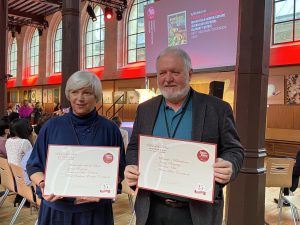
Књига За столом са Словенима добила Гурманово признање Best of the Best
Гурман, који сваке године додељује међународне награде за најбоље књиге на подручју хране и пића, доделио је признања Best of the Best поводом своје 25. годишњице. У Паризу је награђена и књига За столом са Словенима, аутора Јанеза Богатаја. Књигу је на словеначком и енглеском језику објавио Форум словенских култура. Након што је 2016. године
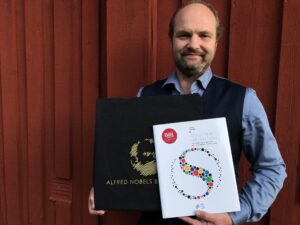
За столом са Словенима на изложби у кући Алфреда Нобела
Након што је 2017. године награђена престижном наградом Gourmand, књига За столом са Словенима – прва светска монографија о словенским кухињама, изложена је у кући Алфреда Нобела у оквиру прославе 25. годишњице награде Gourmand World Cookbook Awards.

Форум словенских култура закључио 15. годину рада
Форум словенских култура закључио је овогодишњу 15. годишњицу рада дипломатско друштвеним догађајем. Припремљен је у сарадњи са Вишом школом за угоститељство, велнес и туризам Блед, др Јанезом Богатајем, Општином Блед и Заводом за културу Блед. На свечаном састанку, партнери и пријатељи ФСК-а су заједно са студентима откривали богатство укуса словенских земаља окупљених у првој светској
ПОЧЕЦИ
Почеци пројекта сежу у 2013. годину, када је директорка Форума словенских култура Андреја Рихтер покренула иницијативу за пројекат о богатству и разноликости укуса словенских култура. Идеју је представила проф. др Јанезу Богатају, једном од највећих светских стручњака за словеначку и словенску етнографију, с посебним нагласком на историји кухиње и савременим трендовима.
Током израде пројекта о избору су обавештене све амбасаде заступљених земаља у Републици Словенији. Њихови представници су потврдили или допунили избор, дали нам низ корисних коментара и смерница, и проверили укусе јела представљених у склопу пројекта.
Књига је објављена 2015. на енглеском, а 2017. на словеначком језику. Истоимена изложба премијерно је приказана 2015. године у Милану у време Expo-а, а касније је била изложена у Естерсунду у Шведској, у Сарајеву у Босни и Херцеговини, као и у Радљу об Драви и Бледу у Словенији.


